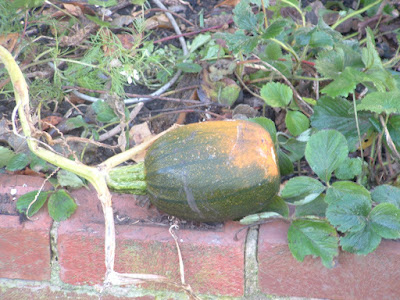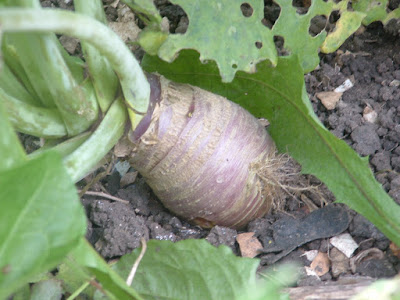 |
| A few last runner beans, October 2017 |
Roots
We finished the last of the carrots in October. Still a few beets growing but I don't have high hopes for them. Picked plenty of celery, and lots more to come for November. Harvested a few spring onions (grown in a pot). Resowed Roots bed with winter grazing rye seed (green manure), but none sprouted yet.
In 2018's Roots bed (2017's Misc bed), planted out 99 garlic cloves (all own grown garlic), and 35 shallot bulbs (7 from own grown, the rest bought).
Peas and Beans
Harvested a few runner beans in October, but finished them by the end of the month. Left some growing for seed. Put broad beans in a plastic bag to sprout, for planting out in early November (will plant out in 2018's Peas and Beans bed, which is 2017's Potatoes bed).
Brassicas
Brussels sprouts staked up, and growing new leaves and sprouts, after earlier caterpillar damage; none harvested yet and plants still small. Purple sprouting broccoli growing very tall and sturdy.
Planted out four kale seedlings, and two looked still alive at the end of the month. Harvested a very little off two older plants. Winter cabbages growing strongly, but none formed heads yet.
Transplanted about ten spring cabbages into 2018's Brassicas bed (same as 2018's Peas and Beans), some of which were damaged by marauding chickens, but all still growing. Transplanted summer cauliflower seedlings into cold frame with the remaining spring cabbages, and a few cauliflowers into planters next to the cold frame.
Gave up pak choi in planter: slugs. A few turnips forming roots in October, but none harvested; same for rutabagas. Harvested the last two (small) heads of summer cabbage. Harvested a little bit of self-sown mizuna, and more are growing.
Miscellaneous
Harvested another few handfuls of tomatillos in October. Plants still standing at the end of the month, with at least one more handful of fruits on them. Tomatoes finished by the end of the month: cherry tomatoes finally all succumbed to blight, but not without ripening a few last fruits.
Picked the last two squashes at the end of the month. One small, one medium; then pulled up the vines for composting. Picked one orange-ish pumpkin (actually, the chickens did); the rest were all still maturing on the vine at the end of the month: one medium, four small (though the small pumpkins are about the same size or bigger than the medium squash).
Picked the very last of the zuccini at the end of October (four very small fruits), then pulled up the plants. Picked the remaining sweetcorn ears, and also cleared away the plants.
Leeks still growing (including a couple recently discovered ones), none harvested this month. Picked a couple radishes, the last of the leaf lettuce, and started on the arugula and miners lettuce. Still harvesting chard once or twice a week throughout the month. Only a couple winter lettuces still growing: slugs AND chickens...
Potatoes
Both remaining beds dug up and stored: one batch in a paper feed sack in the garage, the other in a plastic tray in the kitchen cupboard. More bug damage in the potatoes from the main bed than in the shadier bed near the chickens, but a similar amount of scab. Eating potatoes all throughout the month of October.
Fruit
Picked all the almonds this month (saving them for our Christmas stollen bread). Picked all three Williams pears at the end of the month to ripen indoors. Picked one alpine strawberry. Still have fruit formed on the raspberries, but none ripened yet.
Moved some strawberries and runners to a new bed in the Perennials section.
Perennials and herbs
Artichokes, asparagus, rhubarb, and sorrel still alive, but all dying back except the sorrel. None harvested.
Rosemary looks dead, but will leave it for now, in the hopes it regrows. Still harvesting a little thyme, chives, basil and dill in October. Picked a few leaves of mint and parsley for eating fresh.








